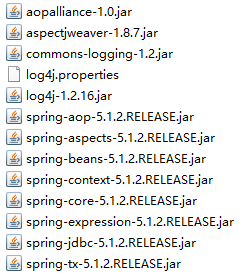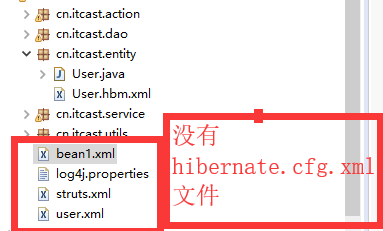Hibernate框架
1 hibernate核心配置文件
(0)orm思想
- 对象关系映射
(1)数据库信息
(2)hibernate信息
(3)映射配置
(4)hibernate核心配置文件
- 如果单纯使用hibernate框架,核心配置文件名称 hibernate.cfg.xml和位置 src下面 固定的
- hibernate和spring整合时候,hibernate核心配置文件名称和位置没有固定要求的
2 hibernate映射配置文件
(1)实体类和数据库表映射关系—使用orm思想
3 hibernate操作的步骤
(1)在spring框架对hibernate框架进行封装,使用hibernateTemplate
Struts2框架
1 Action操作
(1)action创建三种方式
- 继承类 ActionSupport
(2)配置action访问路径
- 创建struts.xml配置文件,这个文件名称和位置固定 src下面的
(3)配置访问action的多个方法
- 使用通配符方式配置
(4)在action获取表单提交数据
- 获取request对象
** 使用ServletActionContext类获取
- 属性封装
- 模型驱动(重点)
- 表达式封装
(5)在action操作域对象
- 使用ServletActionContext获取域对象
(6)配置struts2的过滤器
2 值栈
(1)向值栈放数据
- set方法
- push方法
- 定义变量,生成get方法
(2)从值栈获取数据
- 在jsp中使用struts2标签+ognl获取
- <s:property>
- <s:iterator>
3 拦截器
(1)aop和责任链模式
(2)自定义拦截器
- 继承MethodFilterInterceptor
- 重写类里面的方法
- 配置拦截器和action关联
Spring框架
1 spring核心配置文件
(1)名称和位置没有固定要求
(2)在spring核心配置文件中引入schema约束
2 创建对象
(1)xml配置方式:<bean id=”” class=”” scope=””/>
(2)注解方式:四个注解
3 注入属性(对象类型属性)
(1)xml配置方式:
(2)注解方式:两个注解
- autowired
- resource
3 使用ServletContext对象和监听器实现
(1)在服务器启动时候,加载spring配置文件,创建对象
(2)配置spring的监听器
(3)指定spring配置文件位置
4 jdbcTemplate
5 spring事务配置
(1)xml方式
(2)注解方式
SSH框架整合思想
1 三大框架应用在javaee三层结构

2 struts2框架和spring整合
(1)struts2的action在spring配置

3 spring框架和hibernate框架整合
(1)hibernate的sessionFactory交给spring配置
(2)把hibernate数据库配置交给spring配置

整合struts2和spring框架
1 把struts2的action交给spring管理
2 实现过程
第一步 导入struts2的jar包
(1)导入用于整合的jar包
 (log4j.properties为log4j的日志输出格式,放入src下面)
(log4j.properties为log4j的日志输出格式,放入src下面)
(2)Spring为了整合Struts还需要额外再导入一个jar包:(该包在struts的lib目录下)

(3)导入Struts2的jar包(struts2版本为2.3.24):

(4)创建Action
public class UserAction extends ActionSupport { public String execute() throws Exception { System.out.println("Success...."); return NONE; } }
(5)创建Strut2的核心配置文件
<?xml version="1.0" encoding="UTF-8"?> <!DOCTYPE struts PUBLIC "-//Apache Software Foundation//DTD Struts Configuration 2.3//EN" "http://struts.apache.org/dtds/struts-2.3.dtd"> <struts> <package name="demo" extends="struts-default" namespace="/"> <action name="userAction" class="com.wm.action.UserAction"></action> </package> </struts>
(6)在web.xml中配置struts2的过滤器
<filter> <filter-name>struts2</filter-name> <filter-class>org.apache.struts2.dispatcher.ng.filter.StrutsPrepareAndExecuteFilter</filter-class> </filter> <filter-mapping> <filter-name>struts2</filter-name> <url-pattern>/*</url-pattern> </filter-mapping>
(7)导入Spring整合Web项目的jar包,也就是监控项目启动的监听器所在的jar包

(8)创建Spring的核心配置文件并在其中引入约束
<?xml version="1.0" encoding="UTF-8"?> <beans xmlns="http://www.springframework.org/schema/beans" xmlns:xsi="http://www.w3.org/2001/XMLSchema-instance" xmlns:context="http://www.springframework.org/schema/context" xmlns:aop="http://www.springframework.org/schema/aop" xmlns:tx="http://www.springframework.org/schema/tx" xsi:schemaLocation="http://www.springframework.org/schema/beans http://www.springframework.org/schema/beans/spring-beans.xsd http://www.springframework.org/schema/context http://www.springframework.org/schema/context/spring-context.xsd http://www.springframework.org/schema/aop http://www.springframework.org/schema/aop/spring-aop.xsd http://www.springframework.org/schema/tx http://www.springframework.org/schema/tx/spring-tx.xsd"> </beans>
(9)把action交给Spring进行配置
1 <!-- 配置action的对象 --> 2 <!-- 注意action是多实例的,因此我们这里把scope配置为prototype的 --> 3 <bean id="userAction" class="com.ssh.domain.UserAction" scope="prototype"></bean>
①在spring配置action对象,在struts.xml中也配置action对象
②解决:
只需要在spring里面配置action对象,不要在struts.xml中配置
<struts> <package name="demo1" extends="struts-default" namespace="/"> <!-- class属性里面不写action全路径了,因为写,action对象创建两次 写spring配置的action的bean的id值 --> <action name="userAction" class="userAction"></action> </package> </struts>
可以这样写的原因是我们导入了一个Spring整合Struts2的jar包:struts2-spring-plugin-2.3.24.jar
(10)web.xml中Spring监听器的配置
<listener> <listener-class>org.springframework.web.context.ContextLoaderListener</listener-class> </listener> <context-param> <param-name>contextConfigLocation</param-name> <param-value>classpath:bean.xml</param-value> </context-param>
(11)测试准备
① 所需的为Struts2的核心配置文件:struts.xml
②Spring的配置文件:bean.xml
③项目的配置文件:web.xml
④Struts2的UserAction类
⑤在UserAction中对UserService的调用
⑥UserService中对UserDao的调用
⑦UserDao类的编写
struts.xml
<?xml version="1.0" encoding="UTF-8"?> <!DOCTYPE struts PUBLIC "-//Apache Software Foundation//DTD Struts Configuration 2.3//EN" "http://struts.apache.org/dtds/struts-2.3.dtd"> <struts> <package name="demo1" extends="struts-default" namespace="/"> <!-- class属性里面不写action全路径了,因为写,action对象创建两次 写spring配置的action的bean的id值 --> <action name="userAction" class="userAction"></action> </package> </struts>
bean.xml
<?xml version="1.0" encoding="UTF-8"?> <beans xmlns="http://www.springframework.org/schema/beans" xmlns:xsi="http://www.w3.org/2001/XMLSchema-instance" xmlns:context="http://www.springframework.org/schema/context" xmlns:aop="http://www.springframework.org/schema/aop" xmlns:tx="http://www.springframework.org/schema/tx" xsi:schemaLocation="http://www.springframework.org/schema/beans http://www.springframework.org/schema/beans/spring-beans.xsd http://www.springframework.org/schema/context http://www.springframework.org/schema/context/spring-context.xsd http://www.springframework.org/schema/aop http://www.springframework.org/schema/aop/spring-aop.xsd http://www.springframework.org/schema/tx http://www.springframework.org/schema/tx/spring-tx.xsd"> <bean id="userAction" class="com.wm.action.UserAction"> <property name="userService" ref="userService"></property> </bean> <bean id="userService" class="com.wm.service.UserService"> <property name="userDao" ref="userDaoImp"></property> </bean> <bean id="userDaoImp" class="com.wm.dao.UserDaoImp"></bean> </beans>
web.xml
<?xml version="1.0" encoding="UTF-8"?> <web-app xmlns:xsi="http://www.w3.org/2001/XMLSchema-instance" xmlns="http://xmlns.jcp.org/xml/ns/javaee" xsi:schemaLocation="http://xmlns.jcp.org/xml/ns/javaee http://xmlns.jcp.org/xml/ns/javaee/web-app_3_1.xsd" id="WebApp_ID" version="3.1"> <display-name>spring-day4-ssh</display-name> <listener> <listener-class>org.springframework.web.context.ContextLoaderListener</listener-class> </listener> <context-param> <param-name>contextConfigLocation</param-name> <param-value>classpath:bean.xml</param-value> </context-param> <filter> <filter-name>struts2</filter-name> <filter-class>org.apache.struts2.dispatcher.ng.filter.StrutsPrepareAndExecuteFilter</filter-class> </filter> <filter-mapping> <filter-name>struts2</filter-name> <url-pattern>/*</url-pattern> </filter-mapping> <welcome-file-list> <welcome-file>index.html</welcome-file> <welcome-file>index.htm</welcome-file> <welcome-file>index.jsp</welcome-file> <welcome-file>default.html</welcome-file> <welcome-file>default.htm</welcome-file> <welcome-file>default.jsp</welcome-file> </welcome-file-list> </web-app>
UserAction.java
import com.opensymphony.xwork2.ActionSupport; import com.wm.service.UserService; public class UserAction extends ActionSupport { private UserService userService; public void setUserService(UserService userService) { this.userService = userService; } public String execute() throws Exception { userService.add(); return NONE; } }
UserService.java
public class UserService { private UserDao userDao; public void setUserDao(UserDao userDao) { this.userDao = userDao; } public void add() { userDao.add(); } }
UserDao.java 其实现类
public class UserDaoImp implements UserDao { public void add() { System.out.println("UserDaoImp...."); } }
(12) 测试结果:
访问链接:http://localhost:8080/spring_struts2/userAction
可以在后台观察到如下测试结果:

至此,Spring和Struts2的整合已经完毕,然后是Spring对Hibernate的整合了。
Spring框架整合hibernate框架
1 把hibernate核心配置文件中配置数据库信息,把数据库信息在spring进行配置
2 把hibernate里面的sessionFactory创建交给spring管理
具体实现
第一步 导入hibernate的jar包
(1)导入struts2和hibernate的jar包时候有jar冲突问题
在struts2里面有jar包

在hibernate里面有jar包

删除低版本的jar包
(2)导入spring整合持久化层框架需要导入jar包

第二步 搭建hibernate环境搭建
1 创建实体类
public class User { private Integer uid; private String username; private String password; public Integer getUid() { return uid; } public void setUid(Integer uid) { this.uid = uid; } public String getUsername() { return username; } public void setUsername(String username) { this.username = username; } public String getPassword() { return password; } public void setPassword(String password) { this.password = password; } }
2 配置实体类映射关系
<?xml version="1.0" encoding="UTF-8"?> <!DOCTYPE hibernate-mapping PUBLIC "-//Hibernate/Hibernate Mapping DTD 3.0//EN" "http://www.hibernate.org/dtd/hibernate-mapping-3.0.dtd"> <hibernate-mapping> <!-- 1 配置类和表对应 class标签 name属性:实体类全路径 table属性:数据库表名称 --> <class name="com.wm.entity.User" table="t_user"> <id name="uid" column="uid"> <generator class="native"></generator> </id> <property name="username" column="username"></property> <property name="password" column="password"></property> </class> </hibernate-mapping>
3 创建核心配置文件
<?xml version="1.0" encoding="UTF-8"?> <!DOCTYPE hibernate-configuration PUBLIC "-//Hibernate/Hibernate Configuration DTD 3.0//EN" "http://www.hibernate.org/dtd/hibernate-configuration-3.0.dtd"> <hibernate-configuration> <session-factory> <!-- 第一部分: 配置数据库信息 必须的 --> <!-- <property name="hibernate.connection.driver_class">com.mysql.jdbc.Driver</property> <property name="hibernate.connection.url">jdbc:mysql:///spring_day3</property> <property name="hibernate.connection.username">root</property> <property name="hibernate.connection.password">root</property> --> <!-- 第二部分: 配置hibernate信息 可选的--> <!-- 输出底层sql语句 --> <property name="hibernate.show_sql">true</property> <!-- 输出底层sql语句格式 --> <property name="hibernate.format_sql">true</property> <!-- hibernate帮创建表,需要配置之后 update: 如果已经有表,更新,如果没有,创建 --> <property name="hibernate.hbm2ddl.auto">update</property> <!-- 配置数据库方言 在mysql里面实现分页 关键字 limit,只能使用mysql里面 在oracle数据库,实现分页rownum 让hibernate框架识别不同数据库的自己特有的语句 --> <property name="hibernate.dialect">org.hibernate.dialect.MySQLDialect</property> <!-- 第三部分: 把映射文件放到核心配置文件中 必须的--> <mapping resource="com/wm/entity/User.hbm.xml"/> </session-factory> </hibernate-configuration>
第三步 把hibernate核心配置文件数据库配置,在spring进行配置
(1)把hibernate核心文件中数据库配置去掉了,在spring配置
<bean id="dataSource" class="com.mchange.v2.c3p0.ComboPooledDataSource"> <property name="driverClass" value="com.mysql.jdbc.Driver"></property> <property name="jdbcUrl" value="jdbc:mysql:///spring_day3"></property> <property name="user" value="root"></property> <property name="password" value="root"></property> </bean>
第四步 把hibernate的sessionFactory交给spring配置
(1)服务器启动时候,加载spring配置文件,把配置文件中对象创建
(2)把sessionFactory对象创建在spring配置
(3)因为创建sessionFactory代码不是new出来的,而是多行代码实现的
// 首先在静态代码块中生成出sessionFactory static { try { configuration.configure(configFile); sessionFactory = configuration.buildSessionFactory(); } catch(Exception e) { System.err.println("%%%% Error Creating SessionFactory %%%%"); e.printStackTrace(); } }
(4)spring里面针对上面情况,封装类,配置类对象可以创建sessionFactory
<!-- sessionFactory创建交给spring管理 --> <bean id="sessionFactory" class="org.springframework.orm.hibernate5.LocalSessionFactoryBean"> <!-- 因为在hibernate核心配置文件中,没有数据库配置,数据库配置在spring里面配置,注入dataSource --> <property name="dataSource" ref="dataSource"></property> <!-- 指定使用hibernate核心配置文件 --> <property name="configLocations" value="classpath:hibernate.cfg.xml"></property> </bean>
第五步 在dao里面使用hibernateTemplate
public class UserDaoImp implements UserDao { private HibernateTemplate hibernateTemplate; public void setHibernateTemplate(HibernateTemplate hibernateTemplate) { this.hibernateTemplate = hibernateTemplate; } public void add() { User user = new User(); user.setUsername("lili"); user.setPassword("123"); hibernateTemplate.save(user); System.out.println("UserDaoImp...."); } }
bean.xml中配置
<!-- 创建hibernateTemplate对象 --> <bean id="hibernateTemplate" class="org.springframework.orm.hibernate5.HibernateTemplate"> <!-- 注入sessionFactory --> <property name="sessionFactory" ref="sessionFactory"></property> </bean>
没有配置事务,做操作时候,出现异常
第六步 配置事务
<!-- 第一步 配置事务管理器 --> <bean id="transactionManager" class="org.springframework.orm.hibernate5.HibernateTransactionManager"> <!--注入sessionFactory--> <property name="sessionFactory" ref="sessionFactory"></property> </bean> <!-- 第二步 开启事务注解 --> <tx:annotation-driven transaction-manager="transactionManager"/>
完整:
<?xml version="1.0" encoding="UTF-8"?> <beans xmlns="http://www.springframework.org/schema/beans" xmlns:xsi="http://www.w3.org/2001/XMLSchema-instance" xmlns:context="http://www.springframework.org/schema/context" xmlns:aop="http://www.springframework.org/schema/aop" xmlns:tx="http://www.springframework.org/schema/tx" xsi:schemaLocation="http://www.springframework.org/schema/beans http://www.springframework.org/schema/beans/spring-beans.xsd http://www.springframework.org/schema/context http://www.springframework.org/schema/context/spring-context.xsd http://www.springframework.org/schema/aop http://www.springframework.org/schema/aop/spring-aop.xsd http://www.springframework.org/schema/tx http://www.springframework.org/schema/tx/spring-tx.xsd"> <!-- 配置c3p0连接池 --> <bean id="dataSource" class="com.mchange.v2.c3p0.ComboPooledDataSource"> <!-- 注入属性值 --> <property name="driverClass" value="com.mysql.jdbc.Driver"></property> <property name="jdbcUrl" value="jdbc:mysql:///spring_day3"></property> <property name="user" value="root"></property> <property name="password" value="root"></property> </bean> <!-- sessionFactory创建交给spring管理 --> <bean id="sessionFactory" class="org.springframework.orm.hibernate5.LocalSessionFactoryBean"> <!-- 因为在hibernate核心配置文件中,没有数据库配置,数据库配置在spring里面配置,注入dataSource --> <property name="dataSource" ref="dataSource"></property> <!-- 指定使用hibernate核心配置文件 --> <property name="configLocations" value="classpath:hibernate.cfg.xml"></property> </bean> <!-- 第一步 配置事务管理器 --> <bean id="transactionManager" class="org.springframework.orm.hibernate5.HibernateTransactionManager"> <!--注入sessionFactory--> <property name="sessionFactory" ref="sessionFactory"></property> </bean> <!-- 第二步 开启事务注解 --> <tx:annotation-driven transaction-manager="transactionManager"/> <!-- 配置action的对象 --> <bean id="userAction" class="cn.itcast.action.UserAction" scope="prototype"> <!-- 注入service --> <property name="userService" ref="userService"></property> </bean> <!-- 创建service对象 --> <bean id="userService" class="cn.itcast.service.UserService"> <!-- 注入dao 接口 = 实现类对象 --> <property name="userDao" ref="userDaoImpl"></property> </bean> <!-- 创建实现类对象 --> <bean id="userDaoImpl" class="cn.itcast.dao.UserDaoImpl"> <property name="hibernateTemplate" ref="hibernateTemplate"></property> </bean> <!-- 创建hibernateTemplate对象 --> <bean id="hibernateTemplate" class="org.springframework.orm.hibernate5.HibernateTemplate"> <!-- 注入sessionFactory --> <property name="sessionFactory" ref="sessionFactory"></property> </bean> </beans>
SSH框架整合过程
第一步 导入jar包
第二步 搭建struts2环境
(1)创建action,创建struts.xml配置文件,配置action
(2)配置struts2的过滤器
第三步 搭建hibernate环境
(1)创建实体类
(2)配置实体类和数据库表映射关系
(3)创建hibernate核心配置文件
- 引入映射配置文件
第四步 搭建spring环境
(1)创建spring核心配置文件
(2)让spring配置文件在服务器启动时候加载
- 配置监听器
- 指定spring配置文件位置
第五步 struts2和spring整合
(1)把action在spring配置(action多实例的)
(2)在struts.xml中action标签class属性里面写 bean的id值
第六步 spring和hibernate整合
(1)把hibernate核心配置文件中数据库配置,在spring里面配置
(2)把hibernate的sessionFactory在spring配置
第七步 在dao里面使用hibernateTemplate
(1)在dao注入hibernateTemplate对象
(2)在hibernateTemplate对象中注入sessionFactory
第八步 配置事务
整合其他方式
1 spring整合hibernate时候,可以不写hibernate核心配置文件
(1)把hibernate核心配置文件中,基本信息配置和映射引入都放到spring配置
<!-- sessionFactory创建交给spring管理 --> <bean id="sessionFactory" class="org.springframework.orm.hibernate5.LocalSessionFactoryBean"> <!-- 因为在hibernate核心配置文件中,没有数据库配置,数据库配置在spring里面配置,注入dataSource --> <property name="dataSource" ref="dataSource"></property> <!-- 指定使用hibernate核心配置文件 --> <!-- <property name="configLocations" value="classpath:hibernate.cfg.xml"></property> --> <!-- 配置hibernate基本信息 --> <property name="hibernateProperties"> <props> <prop key="hibernate.show_sql">true</prop> <prop key="hibernate.format_sql">true</prop> <prop key="hibernate.hbm2ddl.auto">update</prop> <prop key="hibernate.dialect">org.hibernate.dialect.MySQLDialect</prop> </props> </property> <!-- 配置映射文件引入 --> <property name="mappingResources"> <list> <value>cn/itcast/entity/User.hbm.xml</value> <!-- <value>....</value> --> </list> </property>

Spring分模块开发
1 在spring里面配置多个内容,造成配置混乱,不利用维护
2 把spring核心配置文件中,一部分配置放到单独的配置文件中,在spring核心配置文件中引入单独配置文件
<?xml version="1.0" encoding="UTF-8"?> <beans xmlns="http://www.springframework.org/schema/beans" xmlns:xsi="http://www.w3.org/2001/XMLSchema-instance" xmlns:context="http://www.springframework.org/schema/context" xmlns:aop="http://www.springframework.org/schema/aop" xmlns:tx="http://www.springframework.org/schema/tx" xsi:schemaLocation="http://www.springframework.org/schema/beans http://www.springframework.org/schema/beans/spring-beans.xsd http://www.springframework.org/schema/context http://www.springframework.org/schema/context/spring-context.xsd http://www.springframework.org/schema/aop http://www.springframework.org/schema/aop/spring-aop.xsd http://www.springframework.org/schema/tx http://www.springframework.org/schema/tx/spring-tx.xsd"> <!-- 配置c3p0连接池 --> <bean id="dataSource" class="com.mchange.v2.c3p0.ComboPooledDataSource"> <!-- 注入属性值 --> <property name="driverClass" value="com.mysql.jdbc.Driver"></property> <property name="jdbcUrl" value="jdbc:mysql:///spring_day04"></property> <property name="user" value="root"></property> <property name="password" value="root"></property> </bean> <!-- sessionFactory创建交给spring管理 --> <bean id="sessionFactory" class="org.springframework.orm.hibernate5.LocalSessionFactoryBean"> <!-- 因为在hibernate核心配置文件中,没有数据库配置,数据库配置在spring里面配置,注入dataSource --> <property name="dataSource" ref="dataSource"></property> <!-- 指定使用hibernate核心配置文件 --> <!-- <property name="configLocations" value="classpath:hibernate.cfg.xml"></property> --> <!-- 配置hibernate基本信息 --> <property name="hibernateProperties"> <props> <prop key="hibernate.show_sql">true</prop> <prop key="hibernate.format_sql">true</prop> <prop key="hibernate.hbm2ddl.auto">update</prop> <prop key="hibernate.dialect">org.hibernate.dialect.MySQLDialect</prop> </props> </property> <!-- 配置映射文件引入 --> <property name="mappingResources"> <list> <value>cn/itcast/entity/User.hbm.xml</value> <!-- <value>....</value> --> </list> </property> </bean> <!-- 第一步 配置事务管理器 --> <bean id="transactionManager" class="org.springframework.orm.hibernate5.HibernateTransactionManager"> <!--注入sessionFactory--> <property name="sessionFactory" ref="sessionFactory"></property> </bean> <!-- 第二步 开启事务注解 --> <tx:annotation-driven transaction-manager="transactionManager"/> <!-- 引入其他spring配置文件 --> <import resource="classpath:user.xml"/> </beans>
user.xml
<?xml version="1.0" encoding="UTF-8"?> <beans xmlns="http://www.springframework.org/schema/beans" xmlns:xsi="http://www.w3.org/2001/XMLSchema-instance" xmlns:context="http://www.springframework.org/schema/context" xmlns:aop="http://www.springframework.org/schema/aop" xmlns:tx="http://www.springframework.org/schema/tx" xsi:schemaLocation="http://www.springframework.org/schema/beans http://www.springframework.org/schema/beans/spring-beans.xsd http://www.springframework.org/schema/context http://www.springframework.org/schema/context/spring-context.xsd http://www.springframework.org/schema/aop http://www.springframework.org/schema/aop/spring-aop.xsd http://www.springframework.org/schema/tx http://www.springframework.org/schema/tx/spring-tx.xsd"> <!-- 配置action的对象 --> <bean id="userAction" class="cn.itcast.action.UserAction" scope="prototype"> <!-- 注入service --> <property name="userService" ref="userService"></property> </bean> <!-- 创建service对象 --> <bean id="userService" class="cn.itcast.service.UserService"> <!-- 注入dao 接口 = 实现类对象 --> <property name="userDao" ref="userDaoImpl"></property> </bean> <!-- 创建实现类对象 --> <bean id="userDaoImpl" class="cn.itcast.dao.UserDaoImpl"> <property name="hibernateTemplate" ref="hibernateTemplate"></property> </bean> <!-- 创建hibernateTemplate对象 --> <bean id="hibernateTemplate" class="org.springframework.orm.hibernate5.HibernateTemplate"> <!-- 注入sessionFactory --> <property name="sessionFactory" ref="sessionFactory"></property> </bean> </beans>